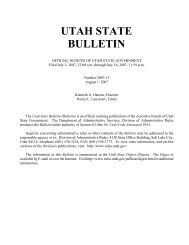Vol. 2010, No. 11 (06/01/2010) PDF - Administrative Rules - Utah.gov
Vol. 2010, No. 11 (06/01/2010) PDF - Administrative Rules - Utah.gov
Vol. 2010, No. 11 (06/01/2010) PDF - Administrative Rules - Utah.gov
You also want an ePaper? Increase the reach of your titles
YUMPU automatically turns print PDFs into web optimized ePapers that Google loves.
DAR File <strong>No</strong>. 33635<br />
NOTICES OF PROPOSED RULES<br />
of the project in accordance with the State's drawings and<br />
specifications. The State or its agent may have primary<br />
responsibility for successful completion of the entire project, or the<br />
contracts may provide that one of the multiple prime contractors has<br />
this responsibility.<br />
(d) Design-Build. In a design-build project, a business<br />
contracts directly with the State to meet the State's requirements as<br />
described in a set of performance specifications. Design<br />
responsibility and construction responsibility both rest with the<br />
design-build contractor. This method can include instances where<br />
the design-build contractor supplies the site as part of the package.<br />
(e) Construction Manager. A construction manager is a<br />
person experienced in construction that has the ability to evaluate<br />
and to implement drawings and specifications as they affect time,<br />
cost, and quality of construction and the ability to coordinate the<br />
construction of the project, including the administration of change<br />
orders. The State may contract with the construction manager early<br />
in a project to assist in the development of a cost effective design.<br />
The construction manager may become the single prime contractor,<br />
or may guarantee that the project will be completed on time and will<br />
not exceed a specified maximum price. This method is frequently<br />
used on fast track projects with the construction manager obtaining<br />
subcontractors through the issuance of multiple bid packages as the<br />
design is developed. The procurement of a construction manager<br />
may be based, among other criteria, on proposals for a management<br />
fee which is either a lump sum or a percentage of construction costs<br />
with a guaranteed maximum cost. If the design is sufficiently<br />
developed prior to the selection of a construction manager, the<br />
procurement may be based on proposals for a lump sum or<br />
guaranteed maximum cost for the construction of the project. The<br />
contract with the construction manager may provide for a sharing of<br />
any savings which are achieved below the guaranteed maximum<br />
cost.<br />
(f) Sequential Design and Construction. Sequential<br />
design and construction denotes a method in which design of<br />
substantially the entire structure is completed prior to beginning the<br />
construction process.<br />
(g) Phased Design and Construction. Phased design and<br />
construction denotes a method in which construction is begun when<br />
appropriate portions have been designed but before design of the<br />
entire structure has been completed. This method is also known as<br />
fast track construction.<br />
. . . . . . .<br />
R33-5-260. Construction Manager: Use.<br />
(1) The State may contract with the construction manager<br />
early in a project to assist in the development of a cost effective<br />
design. The construction manager may become the single prime<br />
contractor, or may guarantee that the project will be completed on<br />
time and will not exceed a specified maximum price. This method<br />
is frequently used on fast track projects with the construction<br />
manager obtaining subcontractors through the issuance of multiple<br />
bid packages as the design is developed. The procurement of a<br />
construction manager may be based, among other criteria, on<br />
proposals for a management fee which is either a lump sum or a<br />
percentage of construction costs with a guaranteed maximum cost.<br />
If the design is sufficiently developed prior to the selection of a<br />
construction manager, the procurement may be based on proposals<br />
for a lump sum or guaranteed maximum cost for the construction of<br />
the project. The contract with the construction manager may<br />
provide for a sharing of any savings which are achieved below the<br />
guaranteed maximum cost.<br />
(2) When entering into any subcontract that was not<br />
specifically included in the construction manager's cost proposal<br />
submitted at the time the contract manager was selected, the<br />
construction manager shall procure that subcontractor by using one<br />
of the source selection methods authorized by these rules in the<br />
same manner as if the subcontract work was procured directly by<br />
the state.<br />
R33-5-262. Construction Manager: Contractual Provisions.<br />
The construction manager's contract shall clearly set forth<br />
the duties and authority of the construction manager in respect to all<br />
the participants in the project. The contract shall also define the<br />
liability of the State and the construction manager for failure to<br />
properly coordinate specialty contractors' work.<br />
R33-5-270. Sequential Design and Construction: Use.<br />
When the state selects the sequential design and<br />
construction method, it shall gather a team to design the project and<br />
provide a complete set of drawings and specifications to use in<br />
awarding the construction contract or contracts. When this team<br />
uses a construction manager he may, in addition to reviewing the<br />
drawings and specifications, assist in separating them into packets<br />
when multiple prime contractors are used. Except for redesign<br />
necessitated by changes in State requirements or problems<br />
encountered during construction, design is complete at the time<br />
construction has begun.<br />
R33-5-280. Phased Design and Construction: Use.<br />
When the phased design and construction method is used,<br />
the architect-engineer, and construction manager, (if one is used)<br />
shall resolve major design decisions, and shall prepare the detail<br />
design work in the sequence necessary to construct the project.<br />
Thus, construction can begin before design is complete for the<br />
entire project. Construction shall only begin after the State's<br />
requirements are set, the overall (schematic) design is complete, and<br />
the complete drawings and specifications for the first construction<br />
phase are ready. The construction manager may also assist in<br />
packaging the various specialty contracts and to [managing]manage<br />
the work under those contracts.<br />
R33-5-281. Phased Design and Construction: Contractual<br />
Provisions.<br />
Contracts shall clearly establish:<br />
(1) architect-engineer's obligation to design the project in<br />
a manner that allows for phased construction to allow phasing of<br />
project design.<br />
(2) specialty contractor's scope of work and duties to<br />
other contractors and the State.<br />
(3) the management rights of the State and its<br />
construction manager when used.<br />
R33-5-3<strong>11</strong>. Bid Security: General.<br />
Invitations for Bids on State construction contracts<br />
estimated to exceed $50,000 shall require the submission of bid<br />
security in an amount equal to at least 5% of the bid, at the time the<br />
UTAH STATE BULLETIN, June <strong>01</strong>, <strong>2<strong>01</strong>0</strong>, <strong>Vol</strong>. <strong>2<strong>01</strong>0</strong>, <strong>No</strong>. <strong>11</strong> 37


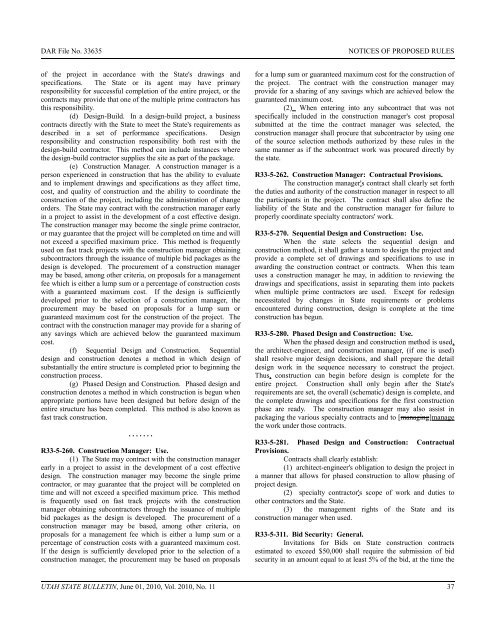


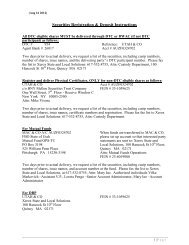

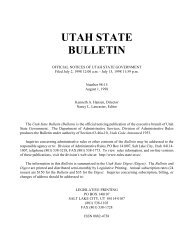
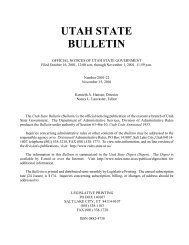



![Lynx avoidance [PDF] - Wisconsin Department of Natural Resources](https://img.yumpu.com/41279089/1/159x260/lynx-avoidance-pdf-wisconsin-department-of-natural-resources.jpg?quality=85)



